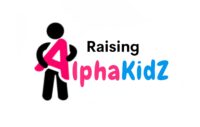Kids Kitchen Garden: Experiencing the Joy of Growing Our Own Food
In a world racing ahead with artificial intelligence and digital screens, I often pause and ask myself: What truly matters for a child growing up today?
Is it coding? Robotics? Online classes?
No! All they need is a little patch of soil, a few seeds, and a kids kitchen garden. No apps. No screens. Just nature, patience, and pure joy.
We began our kitchen garden journey not with big plans but with a curious heart. What bloomed over the weeks was not just vegetables — but something far deeper. Values, emotions, connection.
Nature, Not Screens
If you’d told me a year ago that my 5-year-old kid, would rather dig for weeds on kitchen garden than play video games, I’d have laughed. But here we are—hands dirty, knees muddy, hearts full, and baskets overflowing with chilies, brinjals, lemons, ridge gourds, beans, cucumbers, and more! Today, I want to share why this messy, wondrous journey isn’t just about veggies—it’s about nurturing skills no technology can ever replace.
Our little garden began as a hobby. But today, it’s a sacred ritual — watering plants every morning, checking for new flowers, hunting for sneaky pests, and finally… harvesting from our kitchen garden!
Each plant we’ve grown has a story. A lesson. And a sparkle of childhood joy.
Let me take you through what we’ve been harvesting, what my daughter learned, and how magical this experience has been for both of us, when we began harvesting our own food — together.
C for Cucumber and So Much More
Cucumber was the first thing we harvested on our kitchen garden. Cucumbers love to hide inside leaves! My daughter became a garden detective, peeking under leaves and whispering, “Found one!”
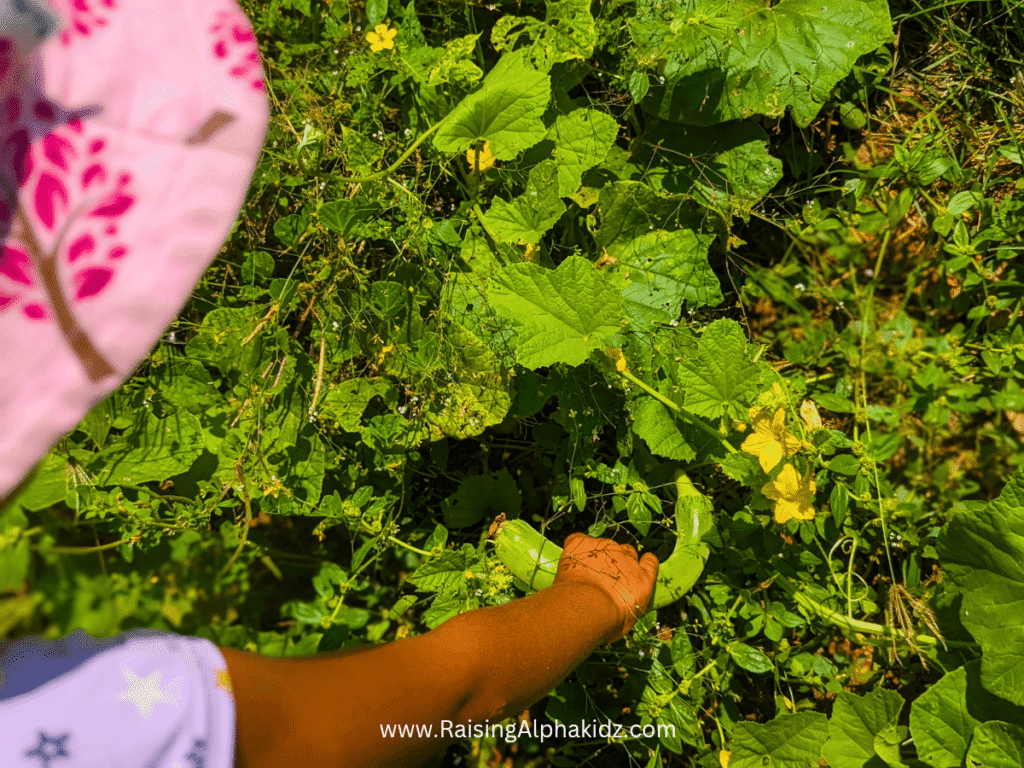
She found a curved cucumber and squealed, “Amma, I got a C-shaped cucumber!”
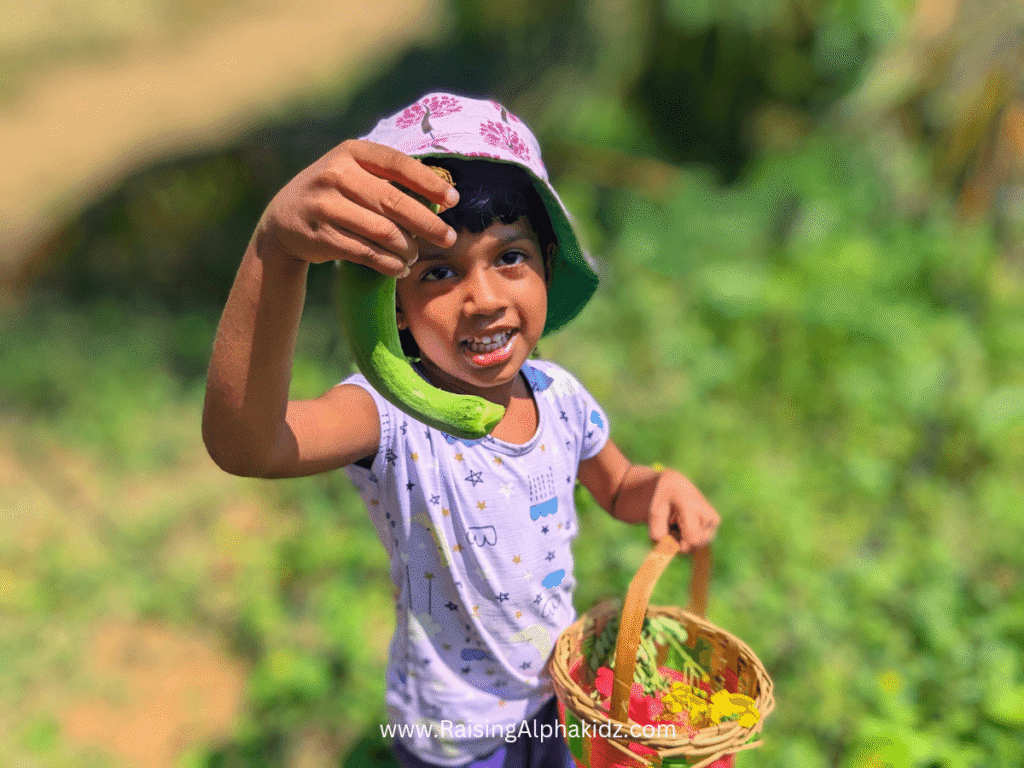
I smiled and said, “Yes, and C is for Cucumber too!” — a sweet little learning moment in the garden.
It was such a fun and unexpected way for her to connect alphabets with real life. Also, it helps in building concentration, sharp eyes, and even cause and effect: when she watered well, more cucumbers appeared.
What she learned:
- How vines grow (they curl and climb!)
- Camouflage and nature’s cleverness
- Harvesting delicate skin vegetables
a Pinch of Spice & Patience
Next, we harvested the red chillies from our kitchen garden when they turned bright and firm. My child was happy to see the plant they watered every day grow chillies we can use in our food.
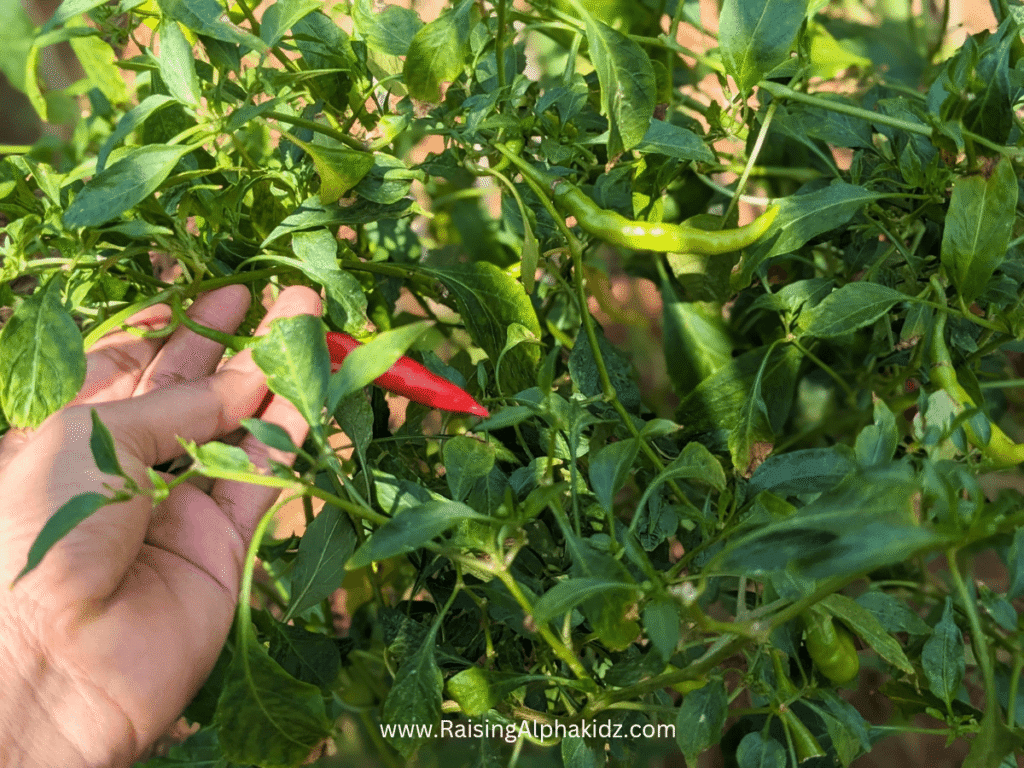
My daughter would check every day, asking, “Is it ready yet?”
I showed my kid how to gently twist and pluck. When we finally plucked our first chilly, she was excited, her face lit up like she found treasure.
But it was the patience in her that surprised me. Weeks of waiting, watering, and watching taught her that good things take time.
She herself began her math lesson — counting, sorting, and arranging by size!
We also observed the plant’s tap root and fibrous roots when we cleared weeds nearby — showing her how roots of different plants spread out differently under the soil.
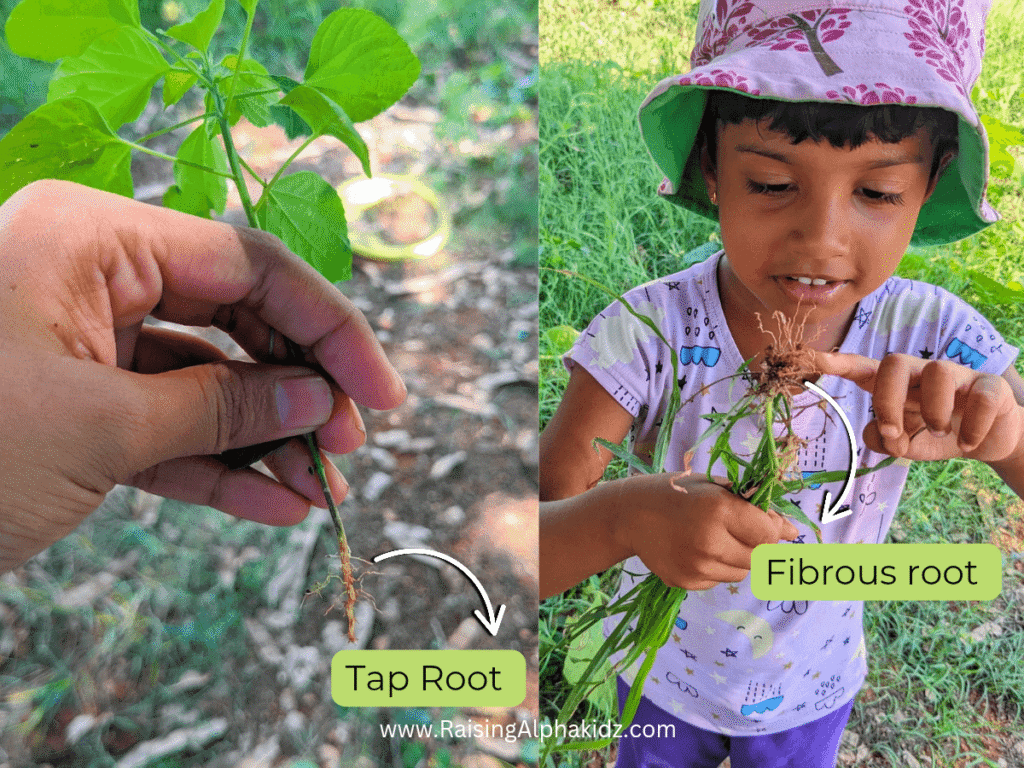
What she learned:
- Patience (It took weeks for those flowers to become chilies!)
- Counting and comparing
- That spicy food starts small!
Harvesting Cotton – Nature’s Fabric Factory
One of the most surprising harvest for her was cotton! We grew a couple of plants on our kids kitchen garden just for fun. And oh, the joy when the dried pods burst open revealing fluffy white cotton. On seeing fluffy white tufts, my child was in awe.
She held one and said, “It feels like a cloud!”
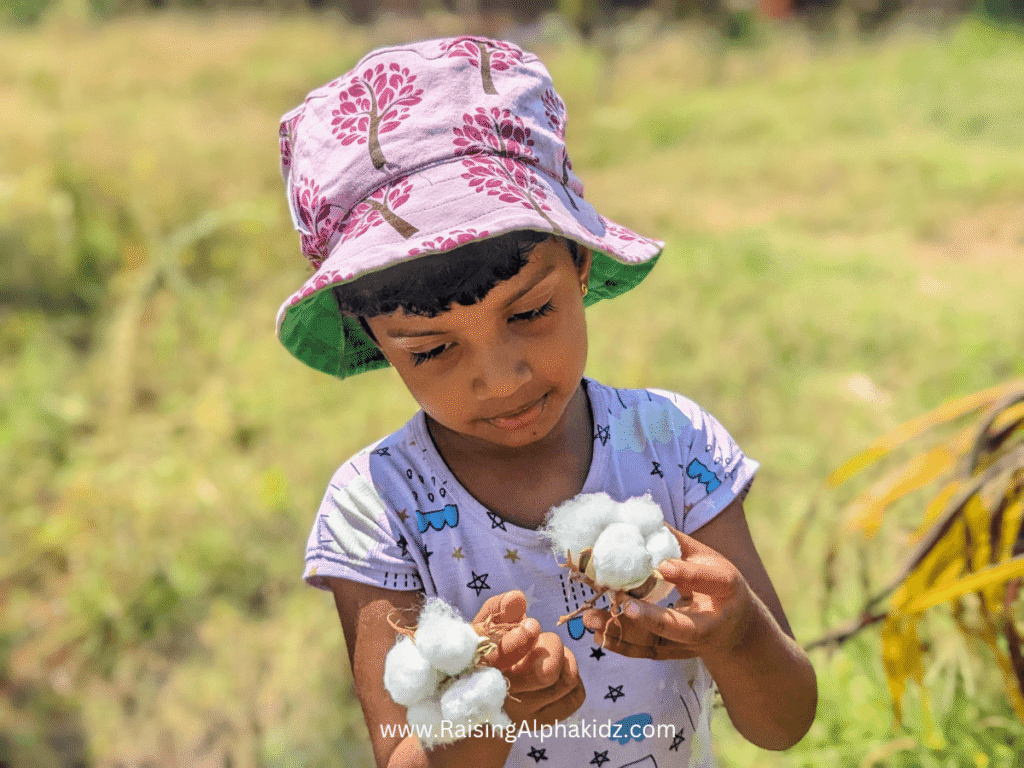
I said that her clothes are made from cotton. She was amazed — “This is what my dress is made of?”
Then came a beautiful experiment — we twisted our harvested cotton into a wick, filled a tiny glass jar with oil, poked a hole on the lid, and made our own oil lamp. As we lit the lamp,she watched in awe — her eyes reflecting the warm, golden flame. “We made our own light, Amma!” she whispered.
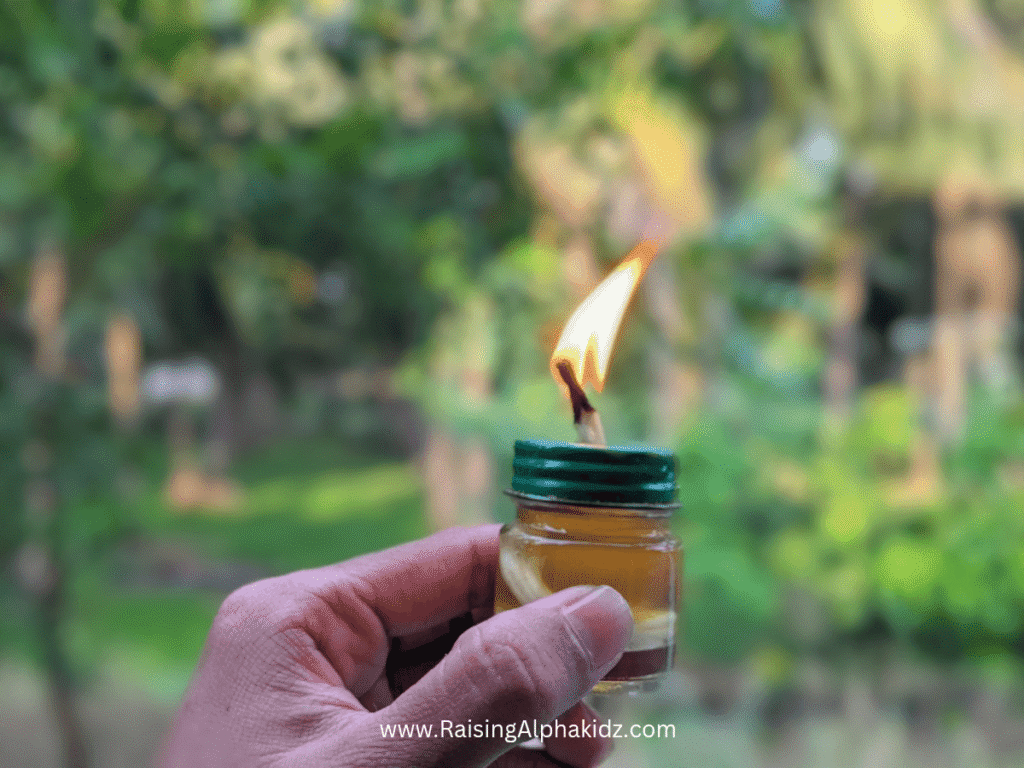
That moment — from seed to soft fiber to a glowing flame — felt like pure magic. A beautiful reminder that even something as small as cotton holds the power to brighten our world.
That moment was empowering.
She learned that nature gives more than food — it gives energy, materials, comfort.
What she learned:
- Nature provides even our clothes!
- Science of seeds and fiber
- Gentle harvesting
Wild & Clean: Homemade Soap Using Common Garden Weeds
We also collected leaves from neem trees nearby and leaves of indian nettle which weeds around our kitchen garden and aloe vera which we planted.
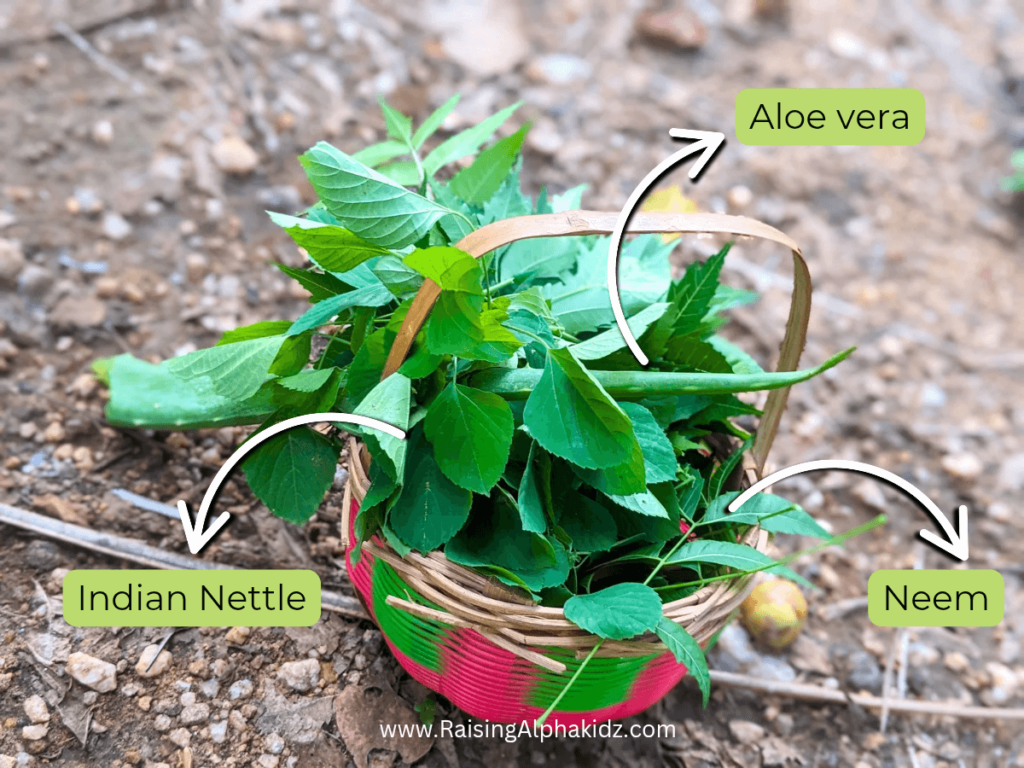
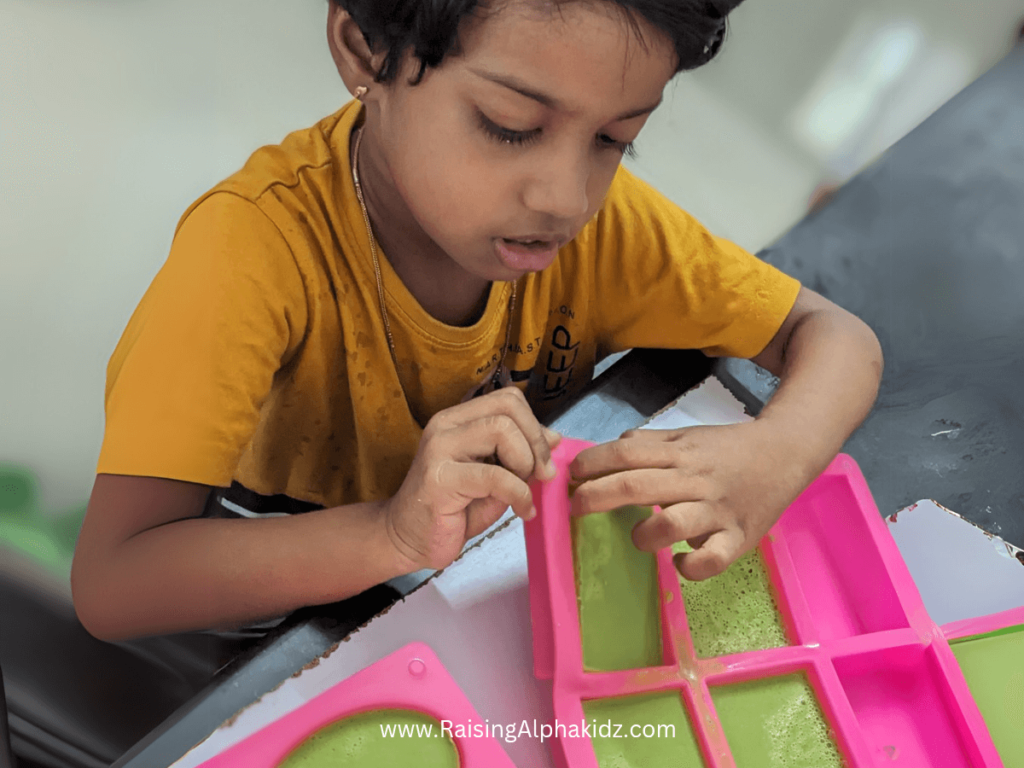
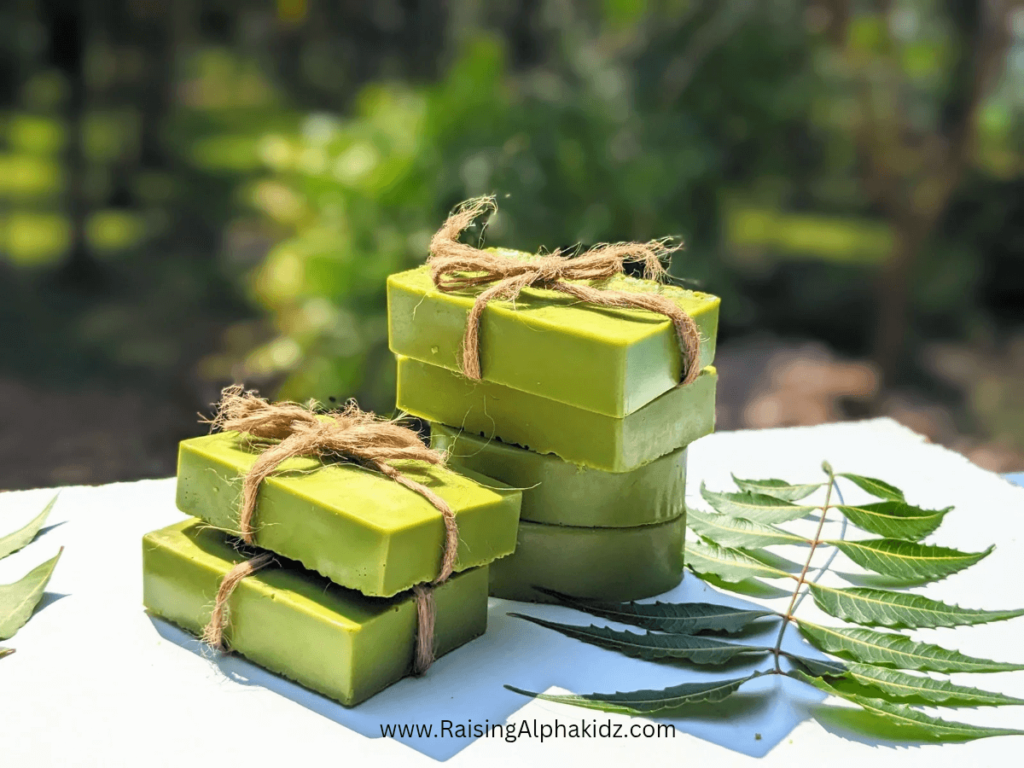
Know More: Soap Making With Kids: A Sustainability Craft
Brinjal (Eggplant) – Purple Prize!

We began our brinjal journey by sowing tiny seeds in a sapling tray.
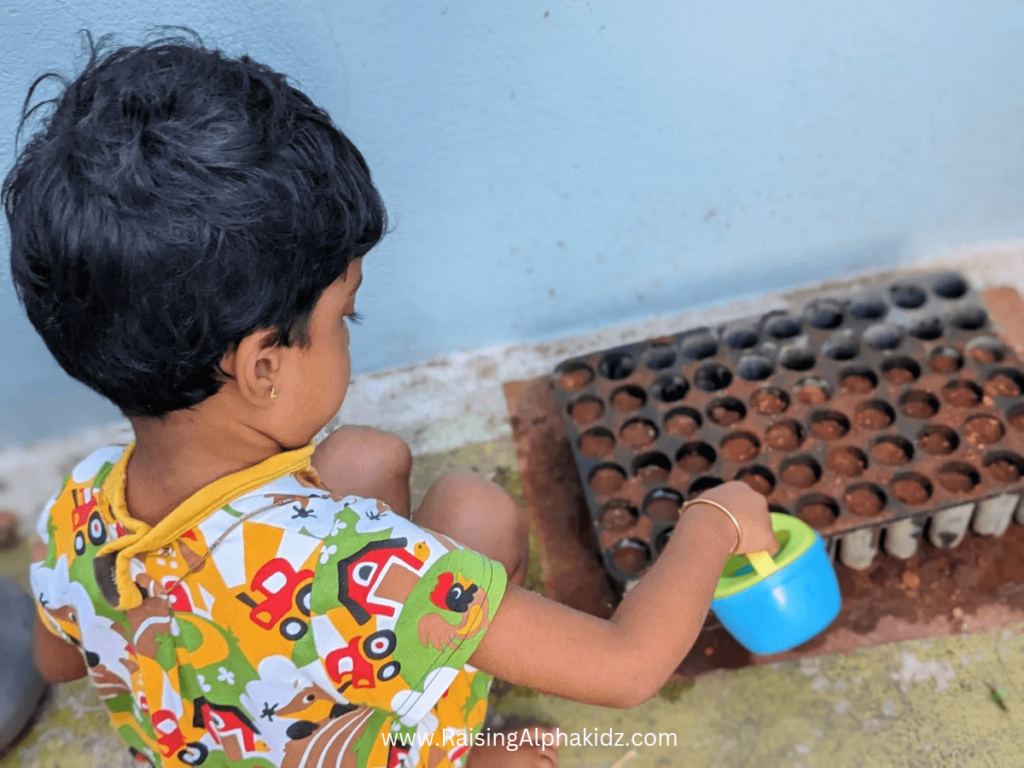
Every day, my little one took great care to water them, and soon, the magic happened — the seeds sprouted into green saplings!
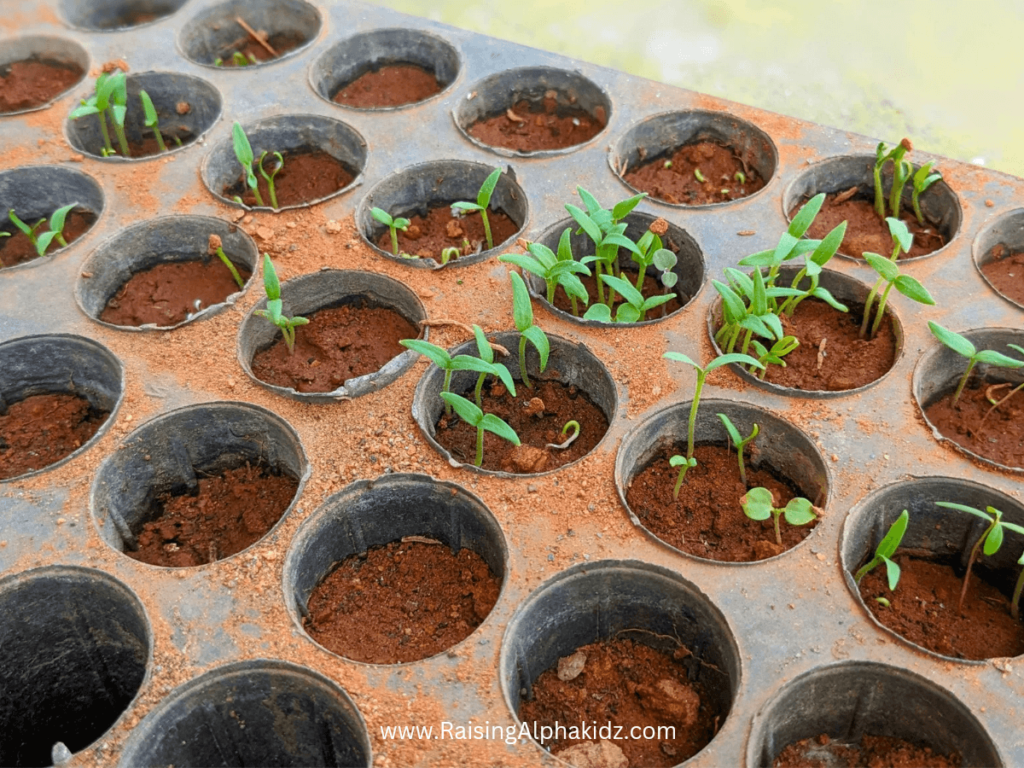
Once strong enough, we carefully transferred the young plants into our kids kitchen garden soil.
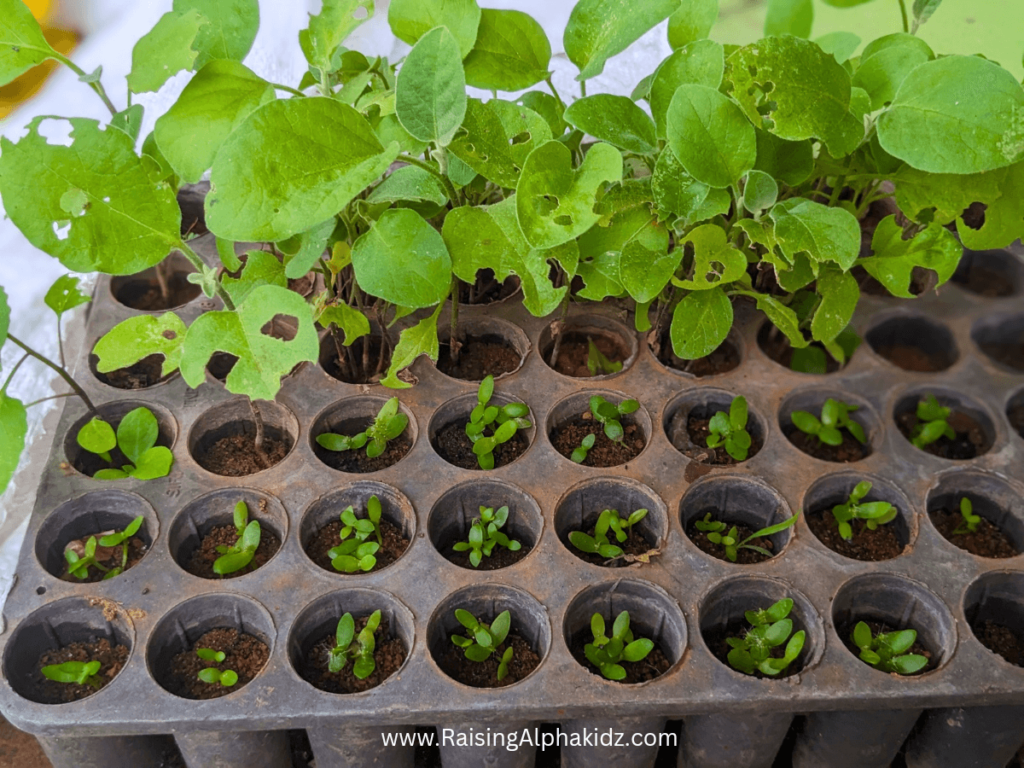
With daily watering and lots of sunshine, the plants grew taller, bloomed with pretty purple flowers , and finally gifted us a beautiful brinjal!
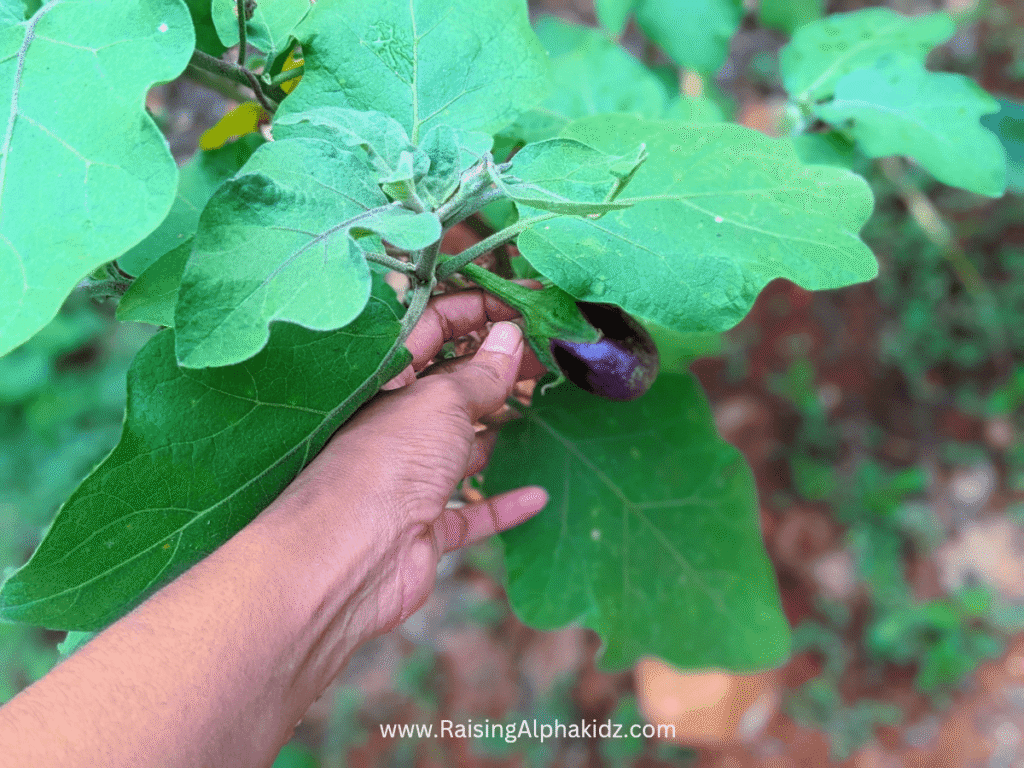
Watching the full life cycle — from seed to harvest — was not just exciting but also deeply fulfilling for both of us. It taught patience, responsibility, and the joy of growing your own food.
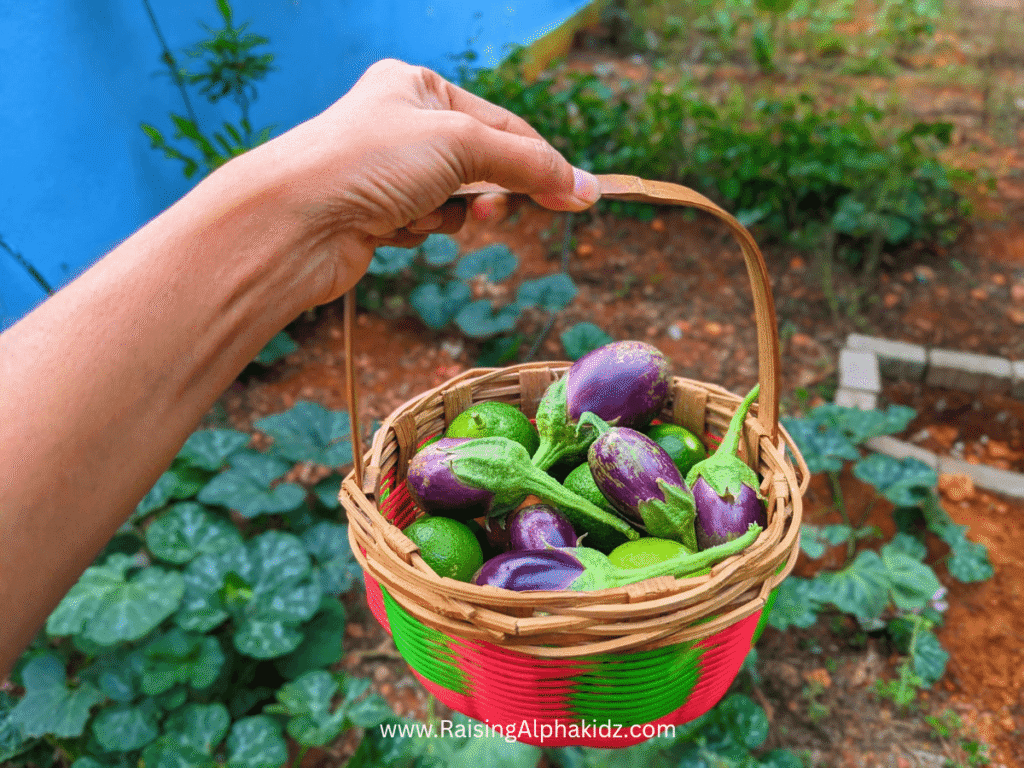
We sliced it open, looked at the seeds, traced its flower-to-fruit story — real, living science in action.
My kid used to hate brinjals. But when she plucked a glossy purple one herself? “Let’s make curry!” she demanded. That night, she ate two servings (healthy eating habits—mic drop!).
Know More: Healthy and Unhealthy Food Sorting Activity
What she learned:
- Identifying ripeness by size and shine
- That not all vegetables are green!
When Life Gave Us Lemons… We Made Bio Enzyme
Our lemon tree is small, but powerful. The lemons turned from deep green to yellowish-green. Our little lemon tree gave us a handful of lemons — pale yellow and strong in scent.
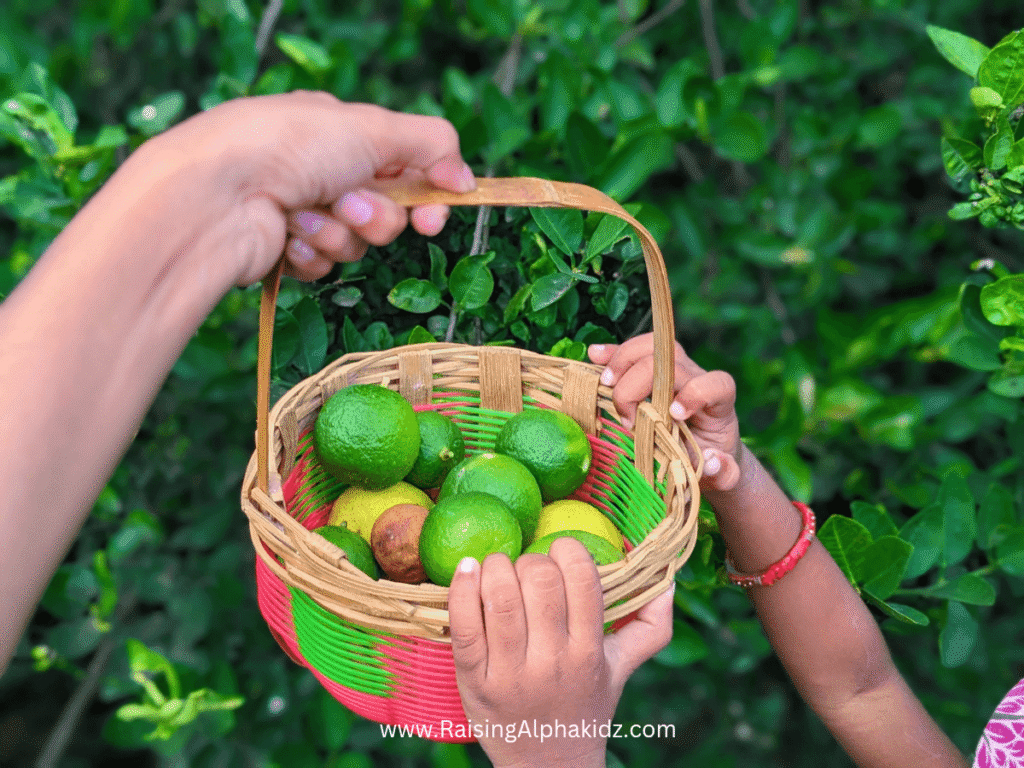
Harvesting lemons also taught her observation — watching color change, and touching the skin to know if it’s ripe.
In a small way, it brought calm — slowing down to see, smell, and feel.
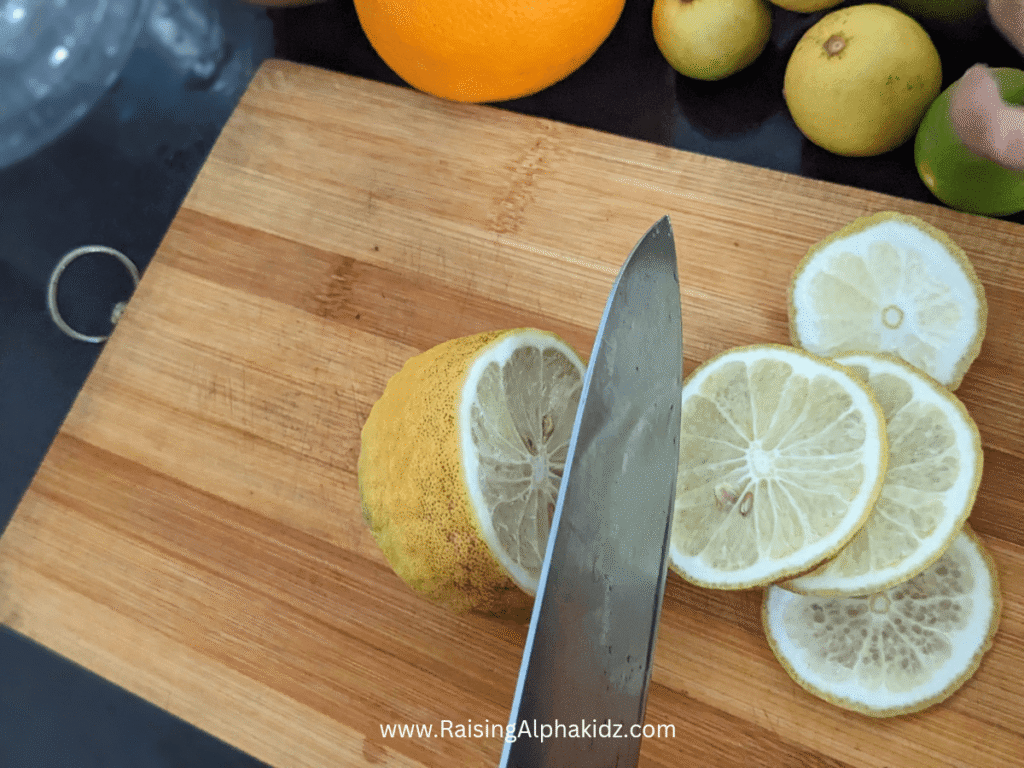
After harvesting some of our lemons, I decided to try something new — we made our very own bio enzyme at home!
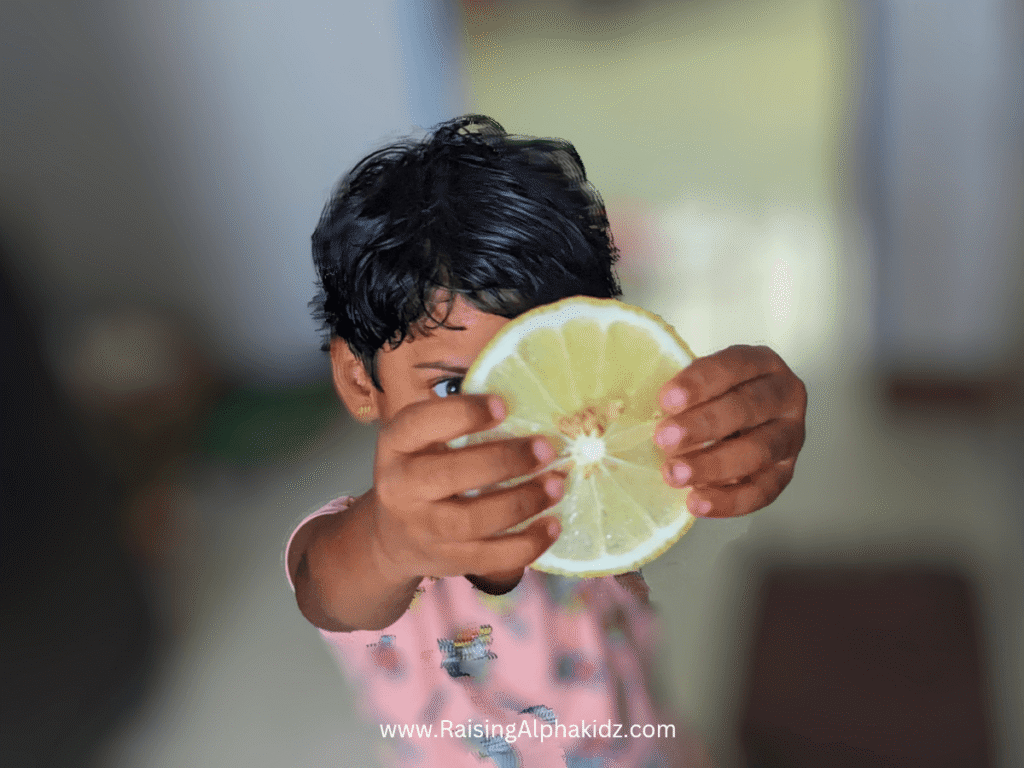
Using sliced lemon, jaggery, and water, we mixed everything in a large jar in the below ratio and let it ferment for a few weeks.
- 3 Parts of lemon
- 1 Part of water
- 10 Parts of water
My daughter helped to pour water and peeked in every few days to check for bubbles. When it was finally ready, we used it as a natural floor cleaner — and she proudly said, “Our lemon cleaned the house!”
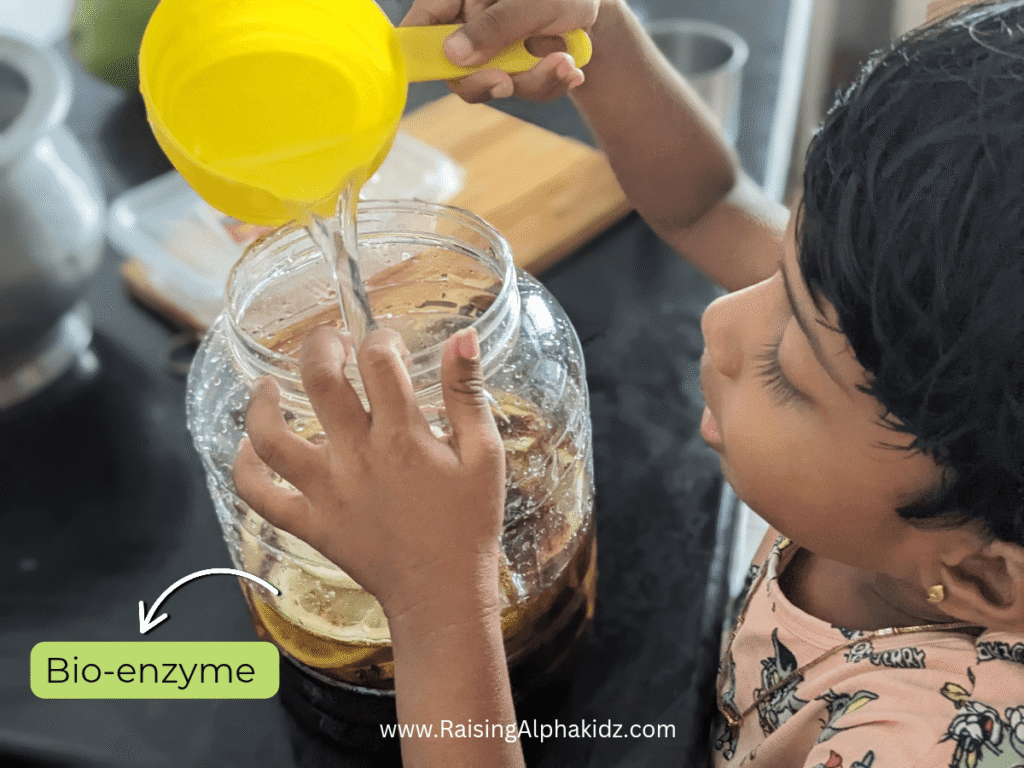
It was such a beautiful way to teach her sustainability that how nothing goes to waste in nature, and how even peels can become powerful, planet-friendly products.
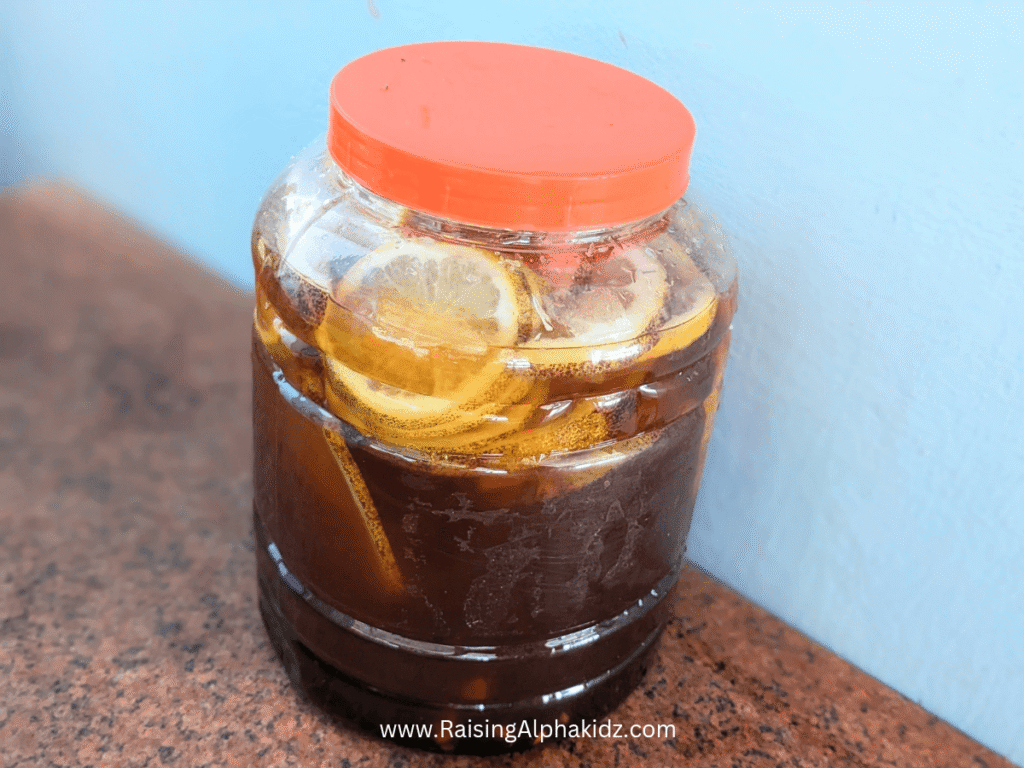
What she learned:
- Color change as a sign of ripeness
- Fragrance as a cue from nature
- Making things out of nature!
DIY Kitchen Compost
We also made a kitchen compost for our garden, with all the vegetable wastes from our kitchen.



Know More: Sustainability For Kids: A Simple Kitchen Compost Project
Beans With Pods & Possibilities
Beans were the easiest for her — because they are fun to pluck. She’s in charge of picking them twice a week.
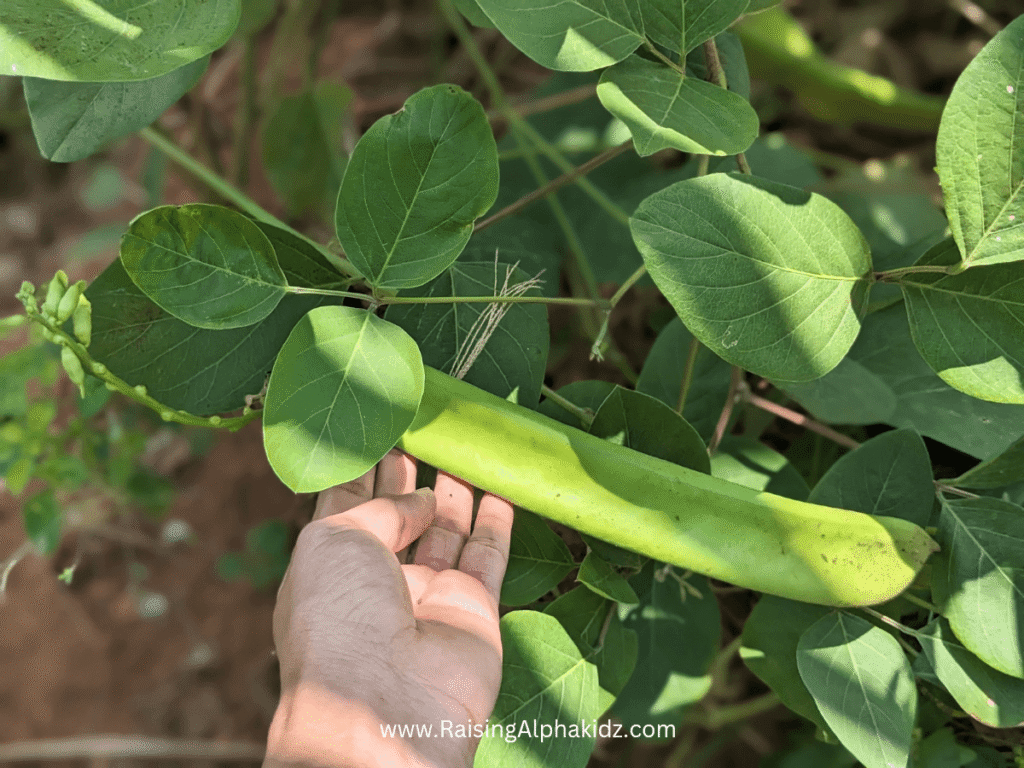
“Look how many grew!” she crowed, filling her basket
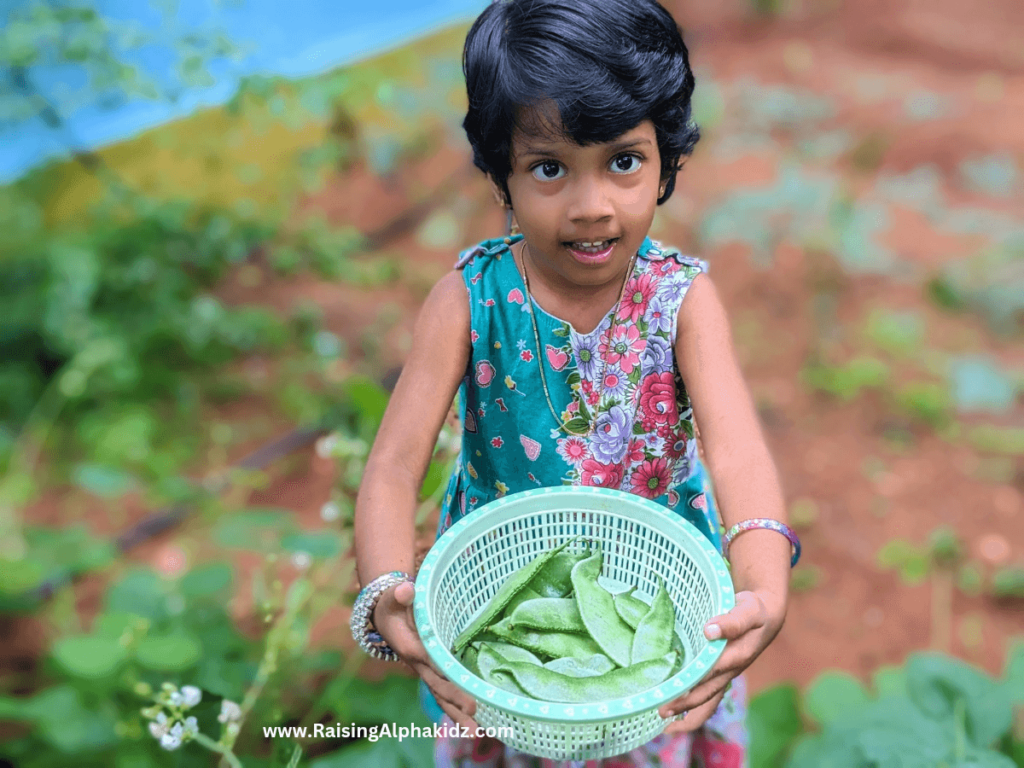
What she learned:
- Fine motor skills from plucking.
- Counting
- Observing stages — from flower to bean
The Forgotten Gourd and a Lesson in Responsibility
Last week, we missed checking on the ridge gourd — and guess what? It turned into a giant, rock-hard gourd! Too tough to eat, but not a waste at all. We decided to let it dry for seeds and to turn it into a natural loofah sponge. My daughter laughed and said, “Next time, I’ll be the ridge gourd monitor!” A fun reminder of how cause and effect works — and how a little responsibility goes a long way in the garden.
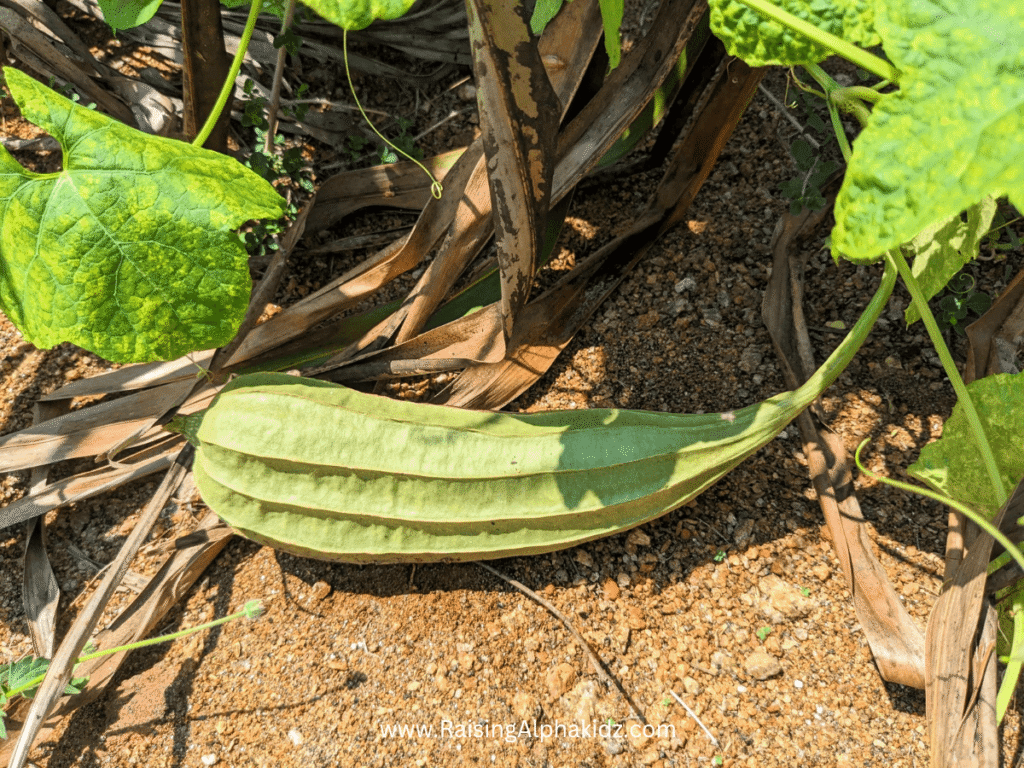
We’d gently tug to check if they were ready.
What she learned:
- Shape and texture awareness
- How tendrils support a plant
- Cooking what we grow
A Jelly In A Shell
This is a summer treat we wait for — the palm tree near our home drops ice apples. Watching someone climb and bring them down was itself a show!
Breaking them open revealed the cool, jelly-like fruit pulp — her favorite!
She squealed, “It’s jelly inside!”
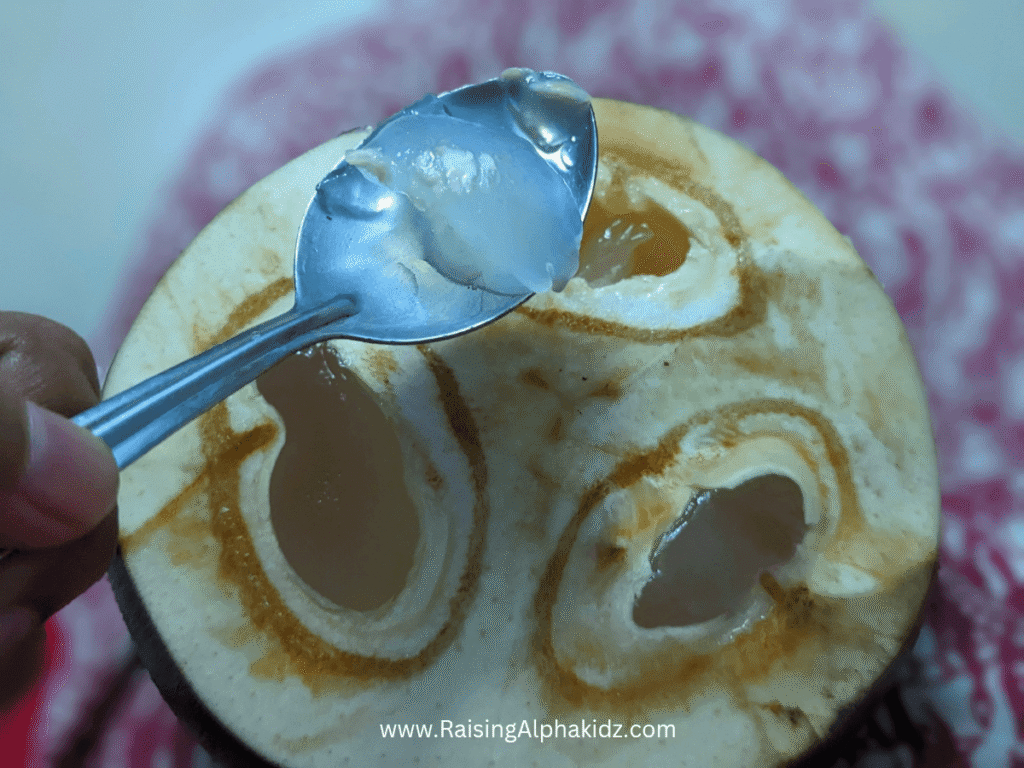
This taught her sustainability — that traditional foods like ice apples come with seasonal respect, not supermarket access.
The Joy of Foraged Berries
In between harvesting veggies, we stumbled upon a little surprise — a blackberry nightshade plant tucked away near the fence, bursting with tiny, shiny purple-black berries.
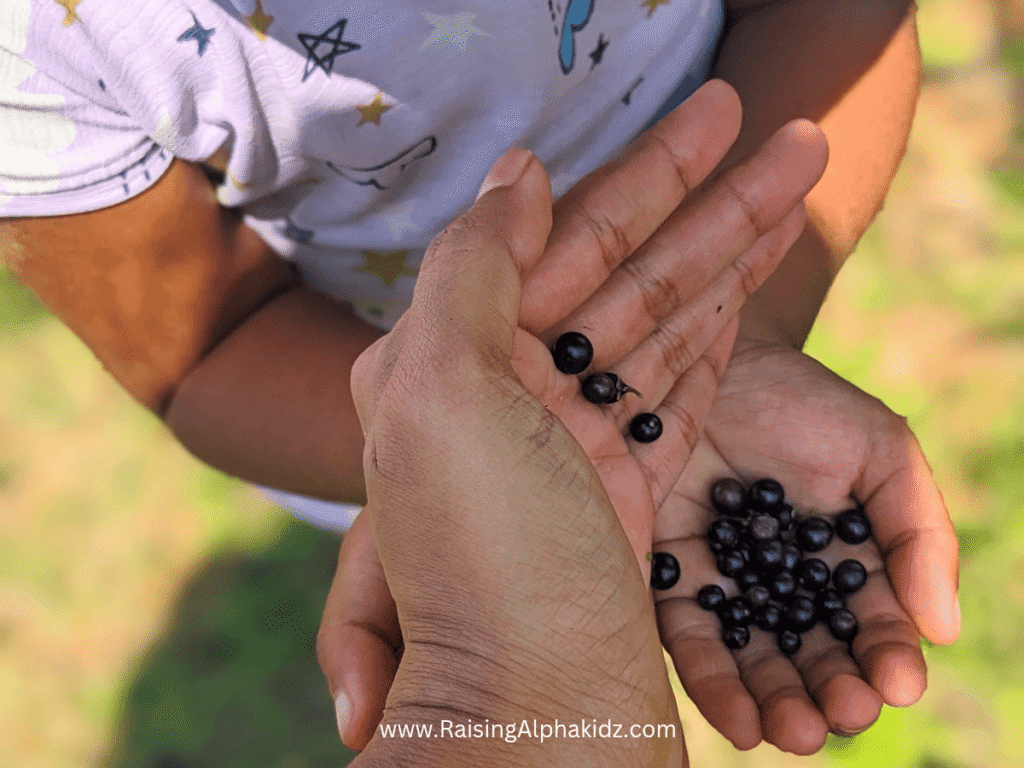
My daughter’s eyes lit up the moment she saw them. Without waiting, I collected it and she popped a few into her mouth and giggled, “It’s a burst of juice, Amma!” Soon she had a mouthful, her smile stained purple, and her joy absolutely contagious. That spontaneous berry break turned into one of the most delightful detours of our garden day — a reminder that nature often leaves sweet little gifts when you’re not even looking for them.
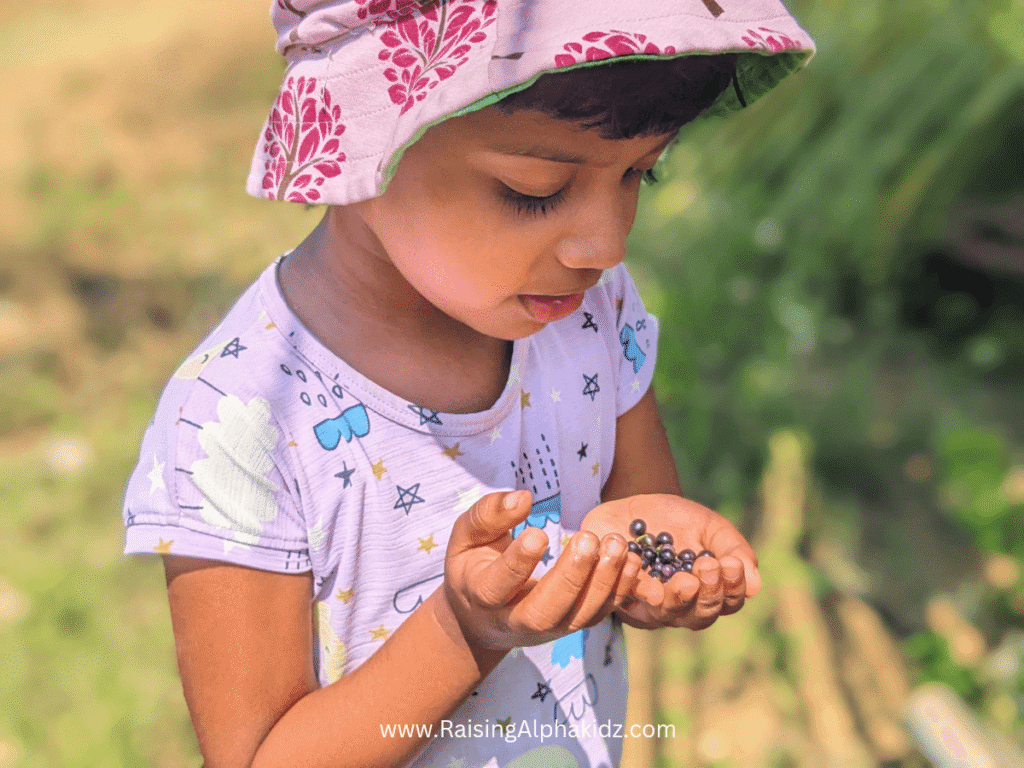
What she learned:
- Fruits grow tall and take effort to harvest
- Taste and texture of summer fruits
- Respect for traditional foods
Spotted! Nature’s Little Helpers at Work
While strolling through the garden, we had a tiny wildlife encounter. My daughter suddenly pointed at a hibiscus flower and exclaimed, “Amma, there’s a bug eating the flower!”
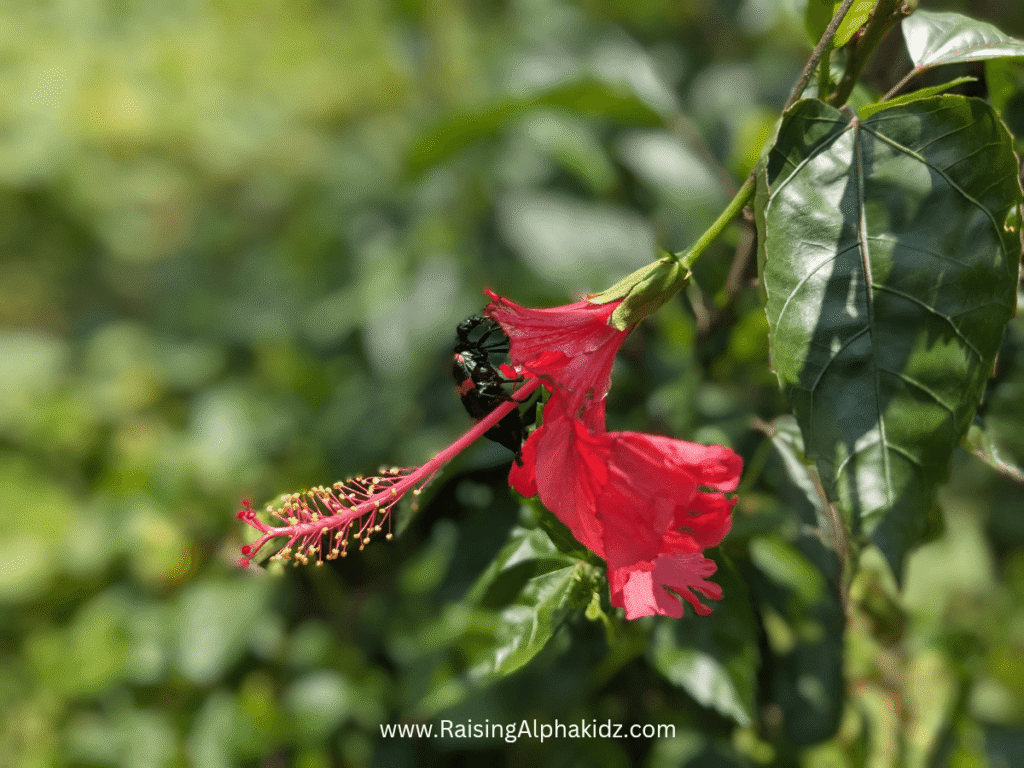
It was a ladybug, calmly sitting on the petal. Nearby, a grasshopper was resting on our bean plant. I hadn’t noticed either — but her curious eyes caught them first!
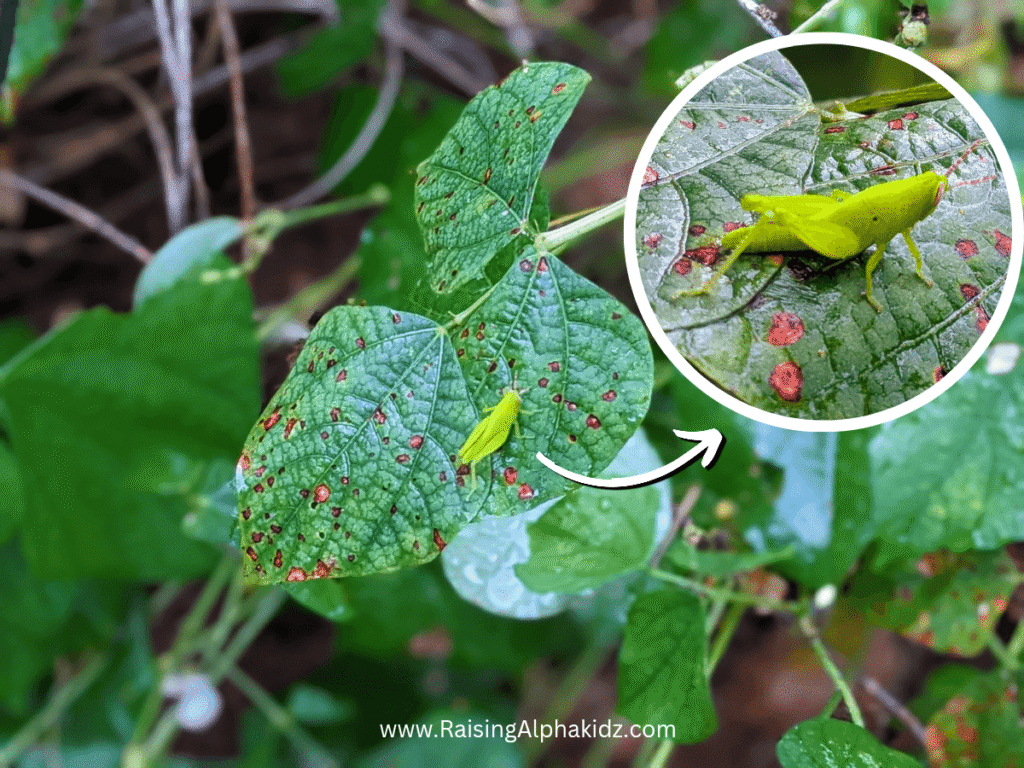
I explained that ladybugs actually help the garden by eating harmful pests like aphids, while grasshoppers, though they nibble on leaves, are also part of the ecosystem. We even spoke about how some insects, like ladybugs and bees, help in pollination — moving pollen from one flower to another so plants can grow fruits. It was a lovely reminder that our garden isn’t just full of plants — it’s a little world buzzing with life and learning.

Know More: The Plant Scavenger Hunt with kids
The Garden Classroom
Many parents used to worry more about kids learning Python, but not planting pumpkins? But here’s the truth:
- Nature is the ultimate teacher. AI can’t replicate the motivation kids feel when seeds she planted become food.
- Emotional intelligence > technical skills.
- Gardening teaches patience (waiting for lemons to ripen),
- responsibility (keeping plants alive),
- gratitude (for rain, sun, soil).
- Real-world science > virtual labs.
- Measuring bean growth (math),
- Studying root systems (biology),
- Composting (chemistry)—it’s science in action, messy and magnificent.
- Happiness that sticks. No app gives the pure happiness of eating a cucumber you grew, or the surprise of ice apples dripping down your chin.
But let me tell you — watching a child pluck a homegrown vegetables, feeling proud, learning to wait, getting dirty in soil, understanding seasons and roots — that’s a life skill no AI can replace.
Life Skills You Can’t Teach on a Screen
Gardening didn’t just teach her biology or food science.
Kitchen Garden teach kids to feel — really feel:
- Patience in waiting for blooms
- Responsibility in daily watering
- Curiosity in watching buds unfold
- Excitement at every harvest
- Gratitude for every edible leaf
- Happiness in muddy toes and sunny noses
- Calmness from watching butterflies land
- Pride in growing her own food
- Motivation to grow more
- Empowerment to create with her hands
- Observation skills sharpened by nature
- Measuring & counting made fun
- Science made simple and beautiful
- Cause and effect learned by doing
- Connection with nature that no screen can simulate
- Sustainability by making things from scratch out of nature
Raising A Rooted Kids in a Wireless World
In today’s high-speed, tech-driven world, when people ask, “Is your child learning coding?”
Just say, “Yes — but also composting, pruning, and planting.”
Because before algorithms, there was soil. Before machines, there was nature.
The ability to grow food, respect the Earth, feel rooted in something real — that’s the foundation every child needs.
Our garden isn’t perfect. Some plants fail. Some don’t sprout. But each success, each flower, each harvest is a celebration.
We laugh, learn, and grow — together.
Grow a Child, Grow a Garden
If you’ve never gardened before — start small. A pot. A sprout. A lemon seed in a cup.
You’re not just growing vegetables. You’re growing patience, wisdom, wonder, and joy in your child.
Because in our garden, we didn’t just harvest brinjals and chilies —
We harvested memories.
We harvested values.
More Gardening Activities To Try Out
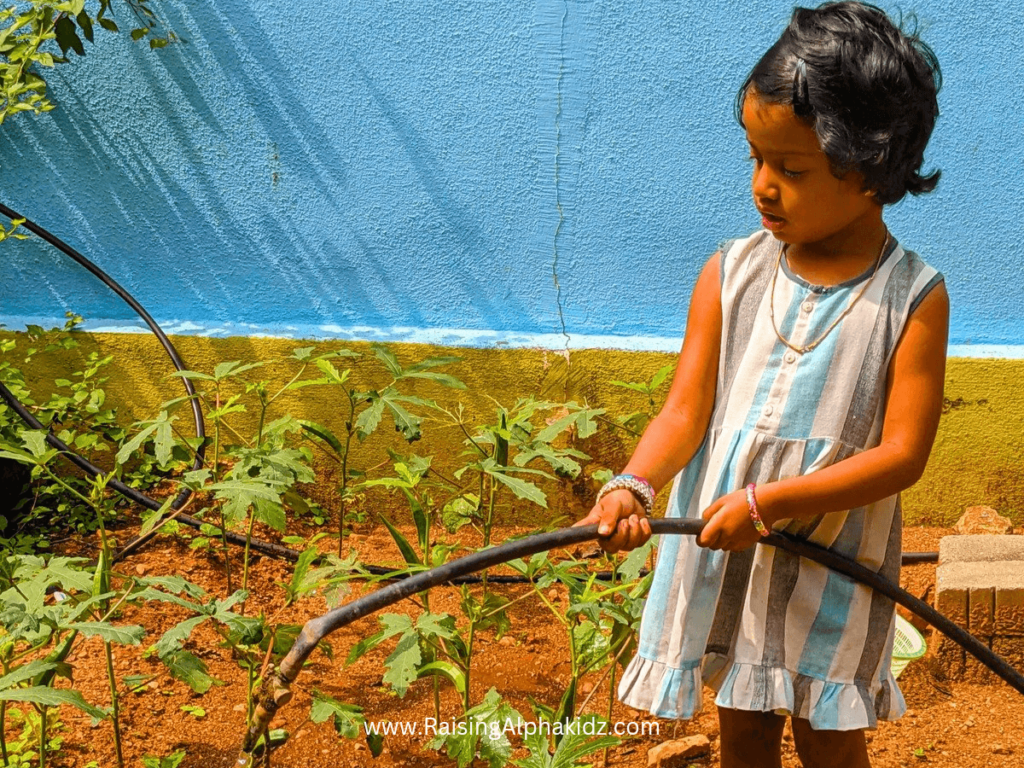
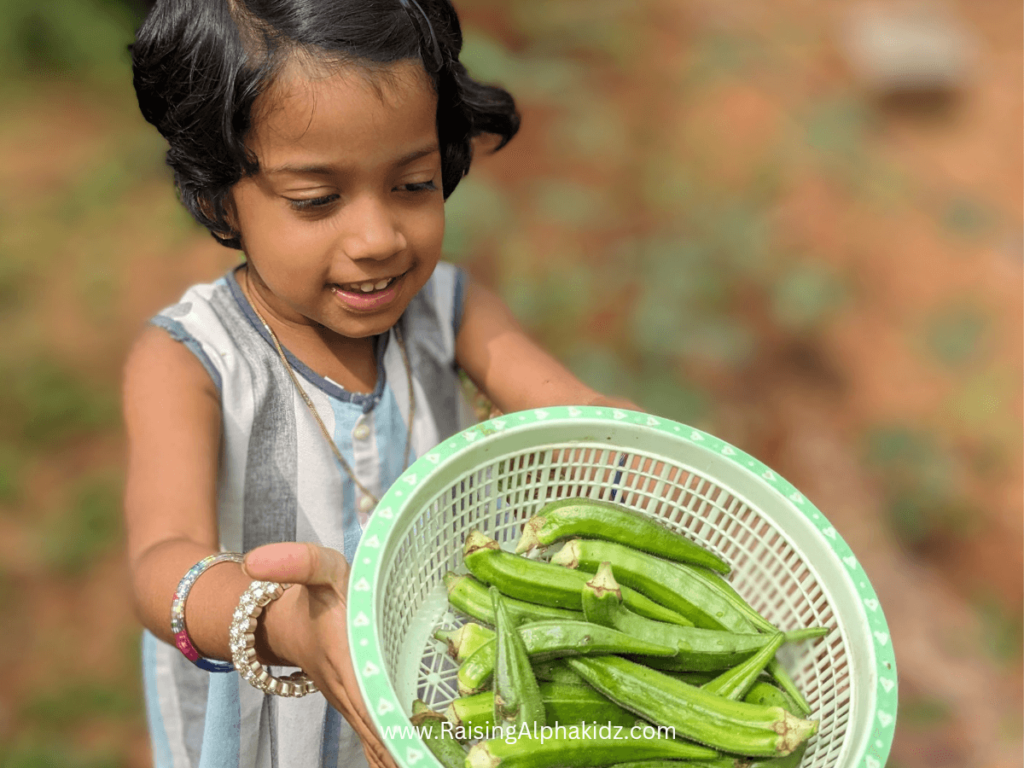

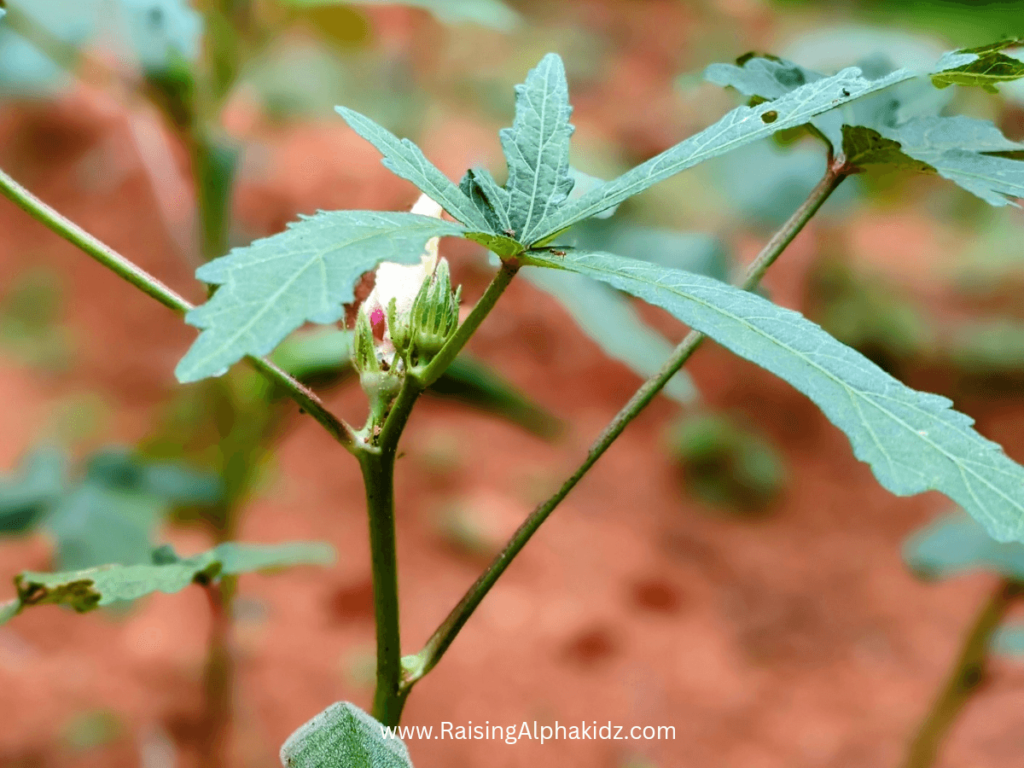
Know More: Gardening Activities With Kids
So if you have a tiny space, a few pots, or even just one sunny window — start your kitchen garden for kids. Involve your child.
Because amidst screens and machines, nature still holds the real magic of learning.
More Nature-Inspired Activities To Try Out
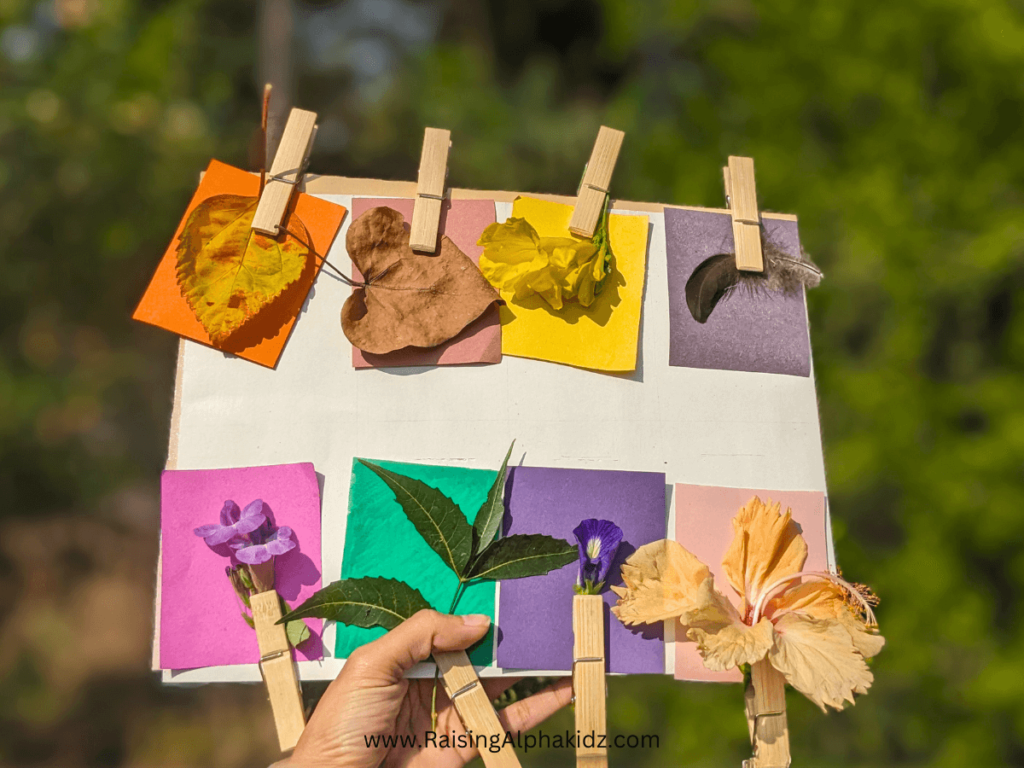



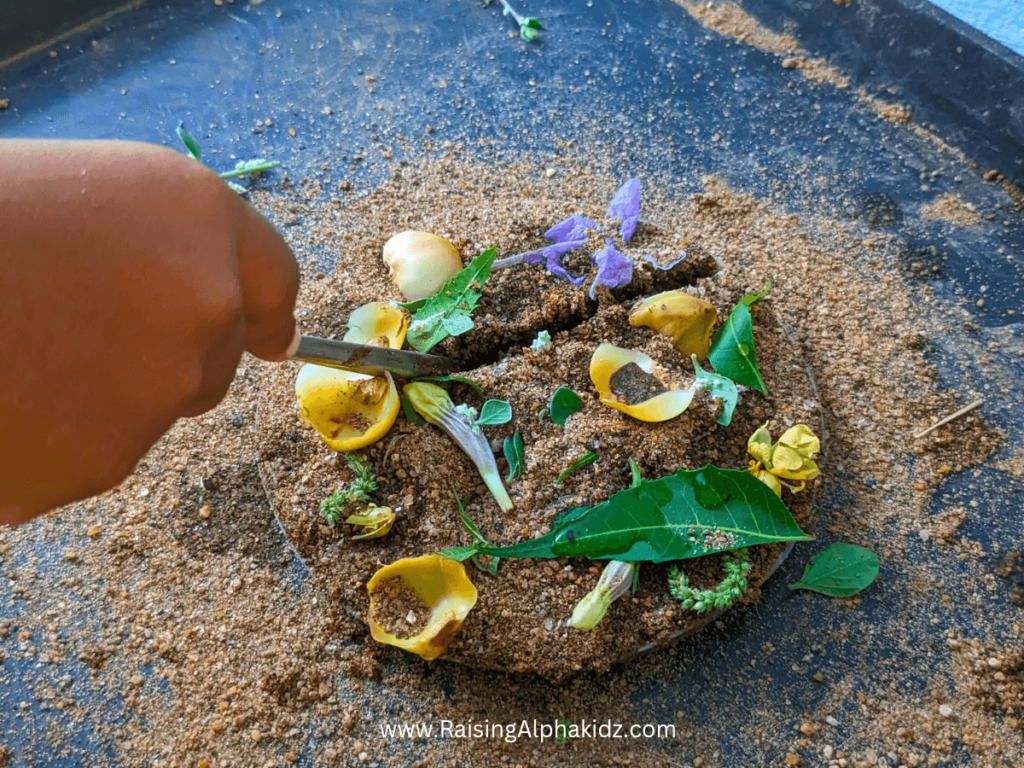

Know More: Nature-Inspired Activities Archive
